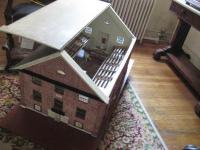Historic St. George’s Church located on 4th and New streets in Philadelphia, Pennsylvania is American Methodism’s oldest church building in continuous service. Based in the teachings of John Wesley (1703-1791), Methodism is a protestant Christian faith. Methodists first began meeting at St. George’s in 1769- six years before the start of the American Revolution and fifteen years before the Methodist Episcopal Church was organized in Baltimore, Maryland in 1784. Francis Asbury, one of the Methodist Episcopal Church’s first bishops, was a pastor at St. George’s and made it his mission to spread Methodism throughout the United States in the late 18th and early 19th centuries. Over a span of 35 years, Asbury traveled hundreds of thousands of miles and ordained several thousand ministers.
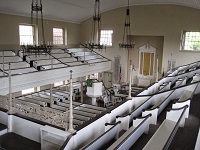
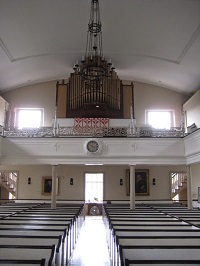
Interior views of St. George's
Responsible for several "firsts" in American Methodism, St. George’s started the first Methodist bookstore and Methodist Home Missionary Society and was also the first to appoint a woman to the role of class leader and to license African Americans as Lay Preachers of Methodism (Richard Allen and Absalom Jones, 1785).
The membership level of St. George's increased throughout the late 18th and early 19th centuries, and was at its largest (3,200 people) in 1835. As a result of the Civil War and the transitioning of St. George's neighborhood from residential to industrial, membership dwindled in the second half of the 19th century. By the start of the 20th century, only 25 people remained in the congregation. St. George's was threatened with demolition when a proposal to build a new bridge linking New Jersey to Philadelphia over the Delaware River surfaced in the 1920s because the church was located right in the middle of the proposed path of the bridge (which would later be known as the Benjamin Franklin Bridge). A group of people protested the destruction of St. George's, a court battle ensued, and ultimately the bridge was shifted just slightly to the south, allowing St. George's to remain at the location it has occupied since the 18th century.

A view to the west from St. George's showing the proximity of the Benjamin Franklin Bridge
Today Historic St. George's Church is once again experiencing membership growth and is referred to as the "cradle of American Methodism." In addition to remaining an active church in the United Methodist Church, St. George’s is the repository for the records of the Historical Society of the Eastern Pennsylvania Conference of the United Methodist Church, which include a manuscripts collection, subject files, records from various Methodist Church organizations, records from over 80 closed churches in the Eastern Pennsylvania Conference, and other documents.
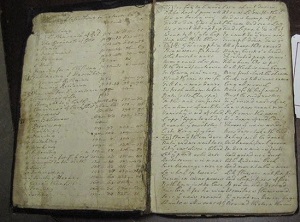

Wesley's manuscript of Methodist hymns (left) and document signed by Asbury and Coke (right)
The manuscripts collection includes papers of various reverends, bishops, and other Methodists, including correspondence, diaries, religious commentary, sermon drafts, pastoral records, autograph books, scrapbooks, photographs, and more. Of special interest in this collection are items relating to prominent Methodists including John Wesley's manuscript of Methodist hymns and documents signed by Francis Asbury and Thomas Coke. The J. D. Long (a Methodist reverend) papers include letters as well as a scrapbook of newspaper articles, many of which he wrote, on abolitionism as related to Methodism. Several women's papers are present in the collection, including some papers and photographs of Anna Jarvis (founder of Mother's Day).
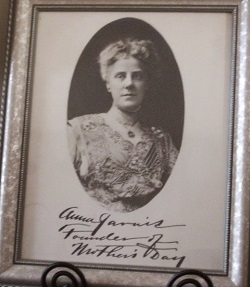
Anna Jarvis (1832-1905)
The records from the closed United Methodist churches (and predecessor denominations, Methodist churches and Methodist Episcopal churches) within the boundaries of the Eastern Pennsylvania Conference of the United Methodist Church, which ranges roughly from Philadelphia to Harrisburg, primarily include vital records (birth, marriage, and death), membership records, trustees' minutes, and Quarterly Conference minutes. Many other types of documents, such as Sunday School records, photographs, event programs, and newspaper clippings, can also be found.

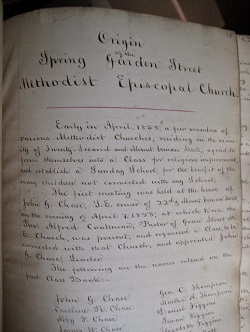
A photograph of the men's bible class in 1926 at the Sarah D. Cooper Memorial Methodist Episcopal Church at 63rd and Girard in Philadelphia (left) and a page from a volume of the Spring Garden Street Methodist Episcopal Church records (right)
In addition to the closed church records, the Historical Society has records from various Methodist Church organizations such as the Laymen's Association, the Preachers' Aid Society, the Philadelphia branch of the Woman's Foreign Missionary Society, the Woman's Home Missionary Society of the Philadelphia Conference, and other organizations.
Genealogists interested in members of the Methodist Church who lived in Eastern Pennsylvania may find the vast amount of vital records in the Historical Society's collections invaluable, while those researching the Methodist Church, especially its early history, might find the manuscripts collections and records relating to St. George's and the Eastern Pennsylvania Conference illuminating. Because of the variety of records available in the collections of the Historical Society of the Eastern Pennsylvania Conference of the United Methodist Church, its materials could be appealing to a wide audience.
Works Consulted
Historic St. George's Church. "History of St. George's - Museum." 2011. Accessed on September 2, 2014. http://www.historicstgeorges.org/museum/welcome/history.

